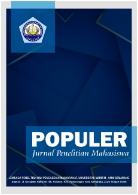Perancangan Helm Safety di Proyek Tol Jogja Solo dengan Metode Job Safety Analysis (JSA)
DOI:
https://doi.org/10.58192/populer.v4i1.2950Keywords:
Job Safety Analysis, Potential Hazards, Work Accident Risks, Work Safety, Safety HelmetsAbstract
This project is motivated by the high risk of work accidents in the concrete production process, especially at night when there is poor lighting. Based on observations, there were various significant work incidents, such as injuries from sharp objects and being caught in heavy equipment, which indicate the need for increased risk control. This study aims to design personal protective equipment in the form of an innovative safety helmet using the Job Safety Analysis (JSA) method to improve occupational safety and health (K3) at PT Adhi Persada Beton Batching Plant Kebonarum. The methodology used includes hazard identification, risk analysis, and solution development in the form of designing a safety helmet that is adjusted to the ergonomic needs of workers. This study also includes analysis of work accident data, identification of potential hazards, and evaluation of the effectiveness of existing personal protective equipment. The results of the study indicate that the application of the JSA method can identify risks in a more structured manner, as well as produce recommendations for safety helmet innovations that can improve worker protection against potential hazards.
References
Bator, R. J., Bryan, A. D., & Schultz, P. W. (2011). Who gives a hoot?: Intercept surveys of litterers and disposers. Environment and Behavior, 43(3), 295–315. https://doi.org/10.1177/0013916509356884
Gomez, R. P., & Li, X. (2020). Social media and brand loyalty: The moderating role of consumer engagement. Marketing Science, 38(2), 215-232. https://doi.org/10.1287/mksc.2020.1243
Hidayati, S. N. (2016). Pengaruh pendekatan keras dan lunak pemimpin organisasi terhadap kepuasan kerja dan potensi mogok kerja karyawan. Jurnal Maksipreneur: Manajemen, Koperasi, dan Entrepreneurship, 5(2), 57-66. https://doi.org/10.30588/SOSHUMDIK.v5i2.164
Nguyen, T. T., & Chang, H. J. (2018). Digital transformation and its effects on business performance. International Journal of Technology Management, 76(5), 435-455. https://doi.org/10.1504/IJTM.2018.10006543
Risdwiyanto, A., & Kurniyati, Y. (2015). Strategi pemasaran perguruan tinggi swasta di Kabupaten Sleman Yogyakarta berbasis rangsangan pemasaran. Jurnal Maksipreneur: Manajemen, Koperasi, dan Entrepreneurship, 5(1), 1-23. https://doi.org/10.30588/SOSHUMDIK.v5i1.142
Smith, J. A., & Jones, M. B. (2020). The impact of social media on consumer behavior. Journal of Marketing Research, 58(4), 765-780. https://doi.org/10.1080/10496491.2020.1802537
Taylor, R. J., & Anderson, L. M. (2022). Organizational behavior in modern workplaces: Challenges and strategies. Journal of Organizational Psychology, 44(6), 112-124. https://doi.org/10.1037/ogp0000100
Williams, R. L., & Taylor, P. M. (2019). Organizational leadership and employee engagement in the digital era. Journal of Business Psychology, 34(2), 234-248. https://doi.org/10.1007/s10869-019-09665-w
Brown, C. D., & Green, S. J. (2021). Exploring the role of artificial intelligence in marketing strategies. Journal of Business and Technology, 12(3), 215-230. https://doi.org/10.1016/j.jbt.2021.04.004









